
Dermestidae are a family of Coleoptera that are commonly referred to as skin beetles. Other common names include larder beetle, hide or leather beetles, carpet beetles, and khapra beetles. There are over 1,800 species described.
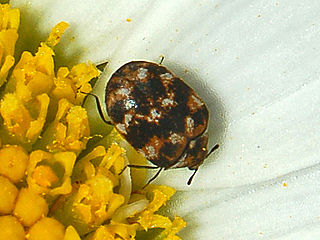
The varied carpet beetle is a 3 mm-long beetle belonging to the family Dermestidae. They are a common species, often considered a pest of domestic houses and, particularly, natural history museums, where the larvae may damage natural fibers and can damage carpets, furniture, clothing, and insect collections. A. verbasci was also the first insect to be shown to have an annual behavioral rhythm and to date remains a classic example of circannual cycles in animals.

Cleridae are a family of beetles of the superfamily Cleroidea. They are commonly known as checkered beetles. The family Cleridae has a worldwide distribution, and a variety of habitats and feeding preferences.

Oryzaephilus surinamensis, the sawtoothed grain beetle, is a beetle in the superfamily Cucujoidea. It is a common, worldwide pest of grain and grain products as well as chocolate, drugs, and tobacco. The species's binomial name, meaning "rice-lover from Suriname," was coined by Carl Linnaeus, who received specimens of the beetle from Surinam. It is also known as the malt beetle and may be referenced in the poem This Is The House That Jack Built in the line "....the rat that ate the malt that lay in the house that Jack built" the malt referenced may not be actual malted grain but a sawtoothed grain beetle.

Spider beetles make up the subfamily Ptininae, in the family Ptinidae. There are approximately 70 genera and 600 species in the subfamily, with about 12 genera and 70 species in North America north of Mexico.

Ptinidae is a family of beetles in the superfamily Bostrichoidea. There are at least 220 genera and 2,200 described species in Ptinidae worldwide. The family includes spider beetles and deathwatch beetles.

Dermestes maculatus is a species of beetle with a worldwide distribution, being present on all continents except Antarctica. In Europe, it is present in all countries.
Home-stored product entomology is the study of insects which infest foodstuffs stored in the home. It deals with the prevention, detection and eradication of the pests. The five major categories of insects considered in this article are flour beetles, the drugstore beetle, the sawtoothed grain beetle, the Indianmeal moth and fruit flies.

Ptinus fur, the whitemarked spider beetle, is a species of spider beetle in the genus Ptinus, with a nearly cosmopolitan distribution.
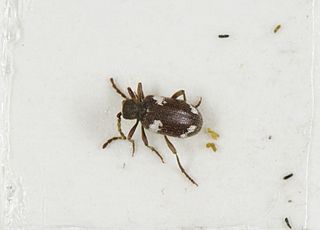
Ptinus sexpunctatus is a species of beetles in the genus Ptinus of the family Ptinidae. It is commonly known as the six-spotted spider beetle.

Ptinus is a genus of beetles distributed throughout much of the world, including Africa, the Australian region, the Palearctic, the Near East, the Nearctic, and the Neotropical realm. It is a member of the subfamily Ptininae, the spider beetles.
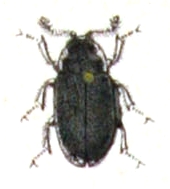
Dermestes frischii is a species of beetle found in the Palearctic, including Europe, tropical Africa, the Near East, the Nearctic, North Africa and East Asia. In Europe, it is known from Albania, Bosnia and Herzegovina, Bulgaria, Corsica, Croatia, the Czech Republic, mainland Denmark, European Turkey, Finland, mainland France, Germany, mainland Greece, Hungary, mainland Italy, Kaliningrad, Moldova, North Macedonia, mainland Norway (doubtful), Poland, Russia, Sardinia, Sicily, Slovakia, mainland Spain, Sweden, Ukraine and Yugoslavia.
Brachypsectra fulva is a species of beetle in the Brachypsectridae family commonly known as the Texas beetle.
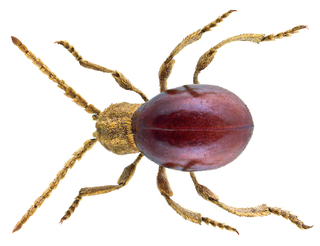
Mezium affine is a species of beetle in the family Ptinidae. Its common names include shiny spider beetle, northern spider beetle, and hood spider beetle. It occurs throughout the Northern Hemisphere, and it is an introduced species in Australia.

Alphitobius diaperinus is a species of beetle in the family Tenebrionidae, the darkling beetles. It is known commonly as the lesser mealworm and the litter beetle. It has a cosmopolitan distribution, occurring nearly worldwide. It is known widely as a pest insect of stored food grain products such as flour, and of poultry-rearing facilities and it is a vector of many kinds of animal pathogens. In larval form, it is an approved novel food in the European Union, and also used as feed.

Dermestes ater is a species of beetle in the family Dermestidae, the skin beetles. It is known commonly as the black larder beetle or incinerator beetle. It is native to North America, but today it is found nearly worldwide. Like several other dermestid beetles, this species is a common pest of stored products.

Trogoderma variabile, the warehouse beetle, is a species of carpet beetle in the family Dermestidae. It is found in Europe, Asia, Central America, North America and Oceania.
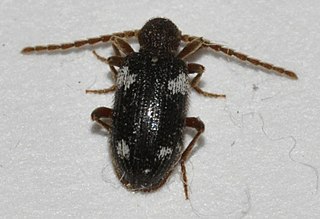
Ptinini is a tribe of spider beetles in the family Ptinidae. There are about 18 genera and at least 120 described species in Ptinini.
Lariophagus distinguendus is a idiobiont ectoparasitoid hymenopteran in the family Pteromalidae, superfamily Chalcidoidea. It parasitizes small beetle larvae concealed in seeds, as well as prepupae and pupae in their cocoons. It is used for the biological control of several beetle pests of stored products, particularly in central Europe, where it is produced commercially and distributed by at least 11 companies.
















